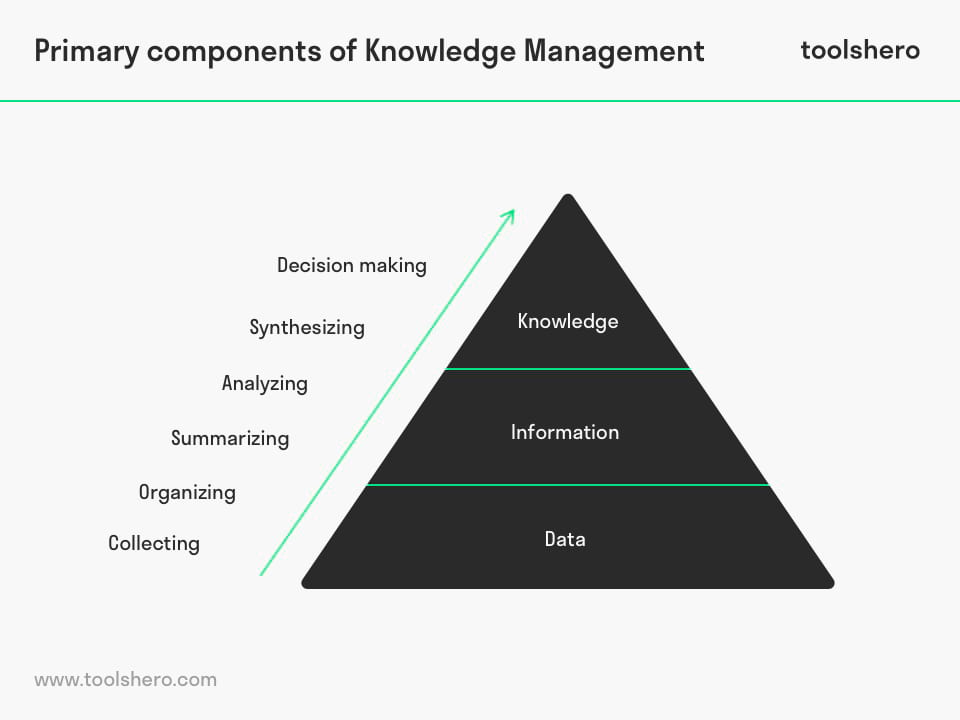Knowledge Management (KM)

Knowledge Management: this article describes Knowledge Management or simply KM in a practical way. After reading you will understand the definition and basics of this powerful management and strategy tool.
What is Knowledge Management (KM)?
Knowledge Management isn’t only about learning and organizing data. It’s a way to maximize potential, increase efficiency, and keep your business running like a well-oiled machine.
Knowledge Management is a method for organizing, retrieving, assessing, and sharing important information assets. It’s about finding the best way to retrieve, record, and share information so that it can be easily accessed by your team in order to make sure everyone is on the same page and performing at their best.
Knowledge Management System
A Knowledge Management System, is an IT system that’s used to retrieve and store this information in order to improve organization, increase efficiency, locate additional knowledge sources, and more.
Having a KM system helps you and your team improve your critical knowledge, increase group innovation, and reach your fullest potential. It is, in a sense, a way to take advantage of your collective “superpowers” in order to get the best results for your company and customers.
Why Use Knowledge Management?
KM has many applications that most business owners don’t even realize, simply because they are all too familiar and comfortable with traditional methods. Fortunately, KM brings business owners into modern times with technology that enables you to work more efficiently and scale your business to new heights.
With Knowledge Management, you gain access to a range of benefits, including:
- Optimized knowledge sharing across your team and company
- Increased efficiency and team collaboration
- Protection of intellectual capital and important company data
- Making the best use of your human capital – your most important asset
- Improvement of company culture and creativity
- Management of large volumes of data and information
- Accurate measurement of business progress, plus practical
goal-setting
Knowledge Management not only allows you and your team to gain access to data and knowledge faster, but it enables you to serve your customers better and faster as well. In fact, one study by McKinsey & Company found that implementing a knowledge base can reduce the time spent searching for important information within a company by up to 35%. An increase in team collaboration and efficiency could easily lead to increased revenue by being able to serve more customers in a fuller capacity.
Knowledge Management for Businesses
If your company is still relying on PDFs and paper documents in order to train employees and share information, you may already recognize how inefficient these methods can be. These types of documents are often difficult to organize, get lost or damaged, are difficult to update, and take longer to share across your company. In the fast-paced business world, you don’t have that time to waste.
That’s why the need for a technology-based knowledge management solution is greater than ever. With the ability to accurately store and quickly share information, having a solid KM strategy helps you avoid major errors and delays in your business.
So, how do you know what type of Knowledge Management your business needs?
Types of Knowledge Management
While there are many methods and tools for Knowledge Management, KM in general can be divided into two categories: Internal Knowledge Management and External Knowledge Management.
Internal Knowledge Management refers to a system that is used within a company in order to optimize knowledge sharing between employees, boost team collaboration, and make the best use of team members individual skills.
External Knowledge Management, on the other hand, is typically customer-facing. It involves documenting information and sharing information with customers in order to address important issues and provide outstanding customer support.
Most businesses need both types of Knowledge Management in order to both increase internal efficiency and provide the best experience for their customers.
Primary Components
Now, it’s time to break down the primary components of Knowledge Management and how they work to optimize the storage and sharing of information in your business.
An effective Knowledge Management strategy involves several layers in order to fix the information bottlenecks in your business. From collecting information to using that information to make informed decisions, you need the process to be as streamlined as possible.
Here, we explain the primary components of Knowledge Management. They include:
- Collecting
- Organizing
- Summarizing
- Analyzing
- Synthesizing
- Decision Making
Collecting Data
The first component of Knowledge Management involves collecting data that is relevant and beneficial to your company. Inclusion of any irrelevant or superfluous data can cause confusion and inaccuracies in your knowledge.
Thus, you should have a dedicated system for collecting data, whether that’s through a designated person or a technological system, i.e. by using Knowledge Management software. The goal is to have a process for collecting data that is essential to your business and excluding data that is not essential.
Organizing Data
Once you have collected all relevant data, it’s necessary to organize it appropriately. This really depends on your own company’s criteria and goals.
For instance, it can be helpful to assign categories to different types of data in order to make sense of what data goes where. Once you have given an “identity” to your data, it then becomes information – that you can then analyze and apply.
Summarizing Information
Next, it’s time to make sense of the organized information by summarizing its meaning. This can be done by adding descriptions to the categories, including images and charts, and other techniques.
Analyzing Information
Beyond simply summarizing the information, you need to analyze its meaning by looking for patterns and relationships.
That is, analyze how bits information relates to one another, what these findings mean, and how this can be used within your company. Again, you can employ analysts to do this or utilize data analyze tools.
Synthesizing Knowledge
In order for “information” to become “knowledge”, it needs to be synthesized into concepts that can then be used constructively within your company.
Some common questions to ask are:
- How can these findings be used to make the company better?
- Who should have access to this information?
- Does this information increase productivity and efficiency? If so, in what areas?
Once you have answers to these questions, it’s time to apply the knowledge to the decision making process.
Applying Knowledge to Decision Making
The last component of Knowledge Management is using the knowledge constructively by applying it to your decision making. This involves determining where to put this knowledge to use. It can also mean helping improving collaboration by involving your team in the decision making.
All of these components build on one another in order to ensure that your data is organized, your information accessible, and your knowledge is able to be utilized in a practical way. Now it’s a matter of finding the right KM system, tools, and resources for your business.
Knowledge Management in Action: Example
Studying the successful deployment of Knowledge Management solutions can show you the strategies and approaches which are most effective.
WealthBar, for example, offers a clean, clear, uncluttered interface which provides users with access to a huge archive of relevant articles. Presenting such a large volume of information in a way that is not intimidating or overwhelming is obviously something that you will want to emulate.
Another good benchmark for this type of service comes in the form of Squeaky’s support site. This not only includes a wealth of useful categories to consider, but also provides users with preview snippets of certain answers to frequently asked questions so that they can get a taste of what is to come.
In both of these examples, it is also worth noting that the search function is placed in a position of prominence. This shows that giving users the option to search for a specific query first is impactful. Browsing the categories is then possible for those who want a less bespoke experience.
Being able to present information to new users in a logical, intuitive way is important, yet unless you see first hand evidence of how this can be achieved successfully, you may not be able to fully appreciate the intricacies of what is involved.
Benefits of Knowledge Management for Business
In summary, Knowledge Management carries a wide range of benefits for business owners. If you are looking to:
- Prevent miscommunication within your company
- Increase teamwork and collaboration
- Improve access to important company data, information, and training materials
- Provide better customer service to your customers
- Have more time to innovate and develop new offers and products in your company
- And much more..
It’s Your Turn
What do you think? Do you use a Knowledge Management system in your business? How has KM helped you increase efficiency and productivity?
Share your experience and knowledge in the comments box below.
More information
- Chui, M. (2012). The Social Economy: Unlocking Value and Productivity through Social Technologies. McKinsey & Company.
- 1Farr, J. L., Sin, H.-P., & Tesluk, P. E. (2003). Knowledge Management Processes and Work Group Innovation. In L. V. Shavinina (Ed.), The international handbook on innovation (pp. 574-586). New York, NY, US: Elsevier Science.
- Stam, C. D. (2007). Knowledge productivity: designing and testing a method to diagnose knowledge productivity and plan for enhancement. Enschede: University of Twente.
How to cite this article:
Hajric, E. (2019). Knowledge Management (KM). Retrieved [insert date] from toolshero: https://www.toolshero.com/management/knowledge-management/
Published on: 06/21/2019/2018 | Last update: 08/20/2023
Add a link to this page on your website:
<a href=”https://www.toolshero.com/management/knowledge-management/”>toolshero: Knowledge Management (KM)</a>







